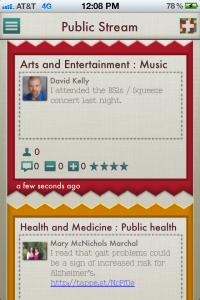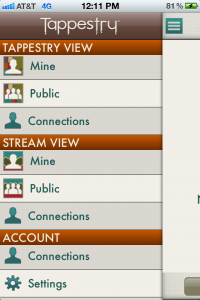One of the growing trends in the learning and development field is the recognition that most learning does not happen within the confines of a course, or packaged within the experience of a formal learning program. The majority of learning comes from less structured experiences, including reading, networking, participating, and countless other daily activities that traditionally haven’t fallen under the heading learning, partly because it wasn’t trackable by the technology in use by most learning organizations.
That may change in the future. Many companies are adopting the ‘next generation of SCORM’ a new standard of data commonly called Tin Can. Tin Can will enable just about any type of learning experience to be documented. Whether it be learning the definition to a new term, attending a concert, completing a Doctorate degree program, or any other type of learning experience, it can all be tracked and added to an individual’s record of learning.
Before I get ahead of myself though, this post is NOT about Tin Can. I do plan to write about it in the near future, after I learn more about it and can better articulate its implications. Tin Can is also a moving target, as it continues to evolve as more companies adopt it. If you want to learn more about Tin Can itself, I’d suggest visiting http://tincanapi.com.
 This post discusses one of the first applications to utilize the Tin Can API, Tappestry, an iPhone app from Float Learning.
This post discusses one of the first applications to utilize the Tin Can API, Tappestry, an iPhone app from Float Learning.
Let’s start with the brief description from the iTunes webpage for the app:
Tappestry is the social network for learning.
For the first time, you can record what you have learned easily and immediately throughout your day. You can come back to it whenever you want. And the best part is you can share with others and learn from others with other social networks and websites.
What did you learn today? With Tappestry, you can track what you have learned and catalog it. Then you can tell everyone. Don’t be shy, you might just meet someone. You can use Tappestry to create and curate your own learning stream. Tappestry is a great place to store your learning and your thoughts and check in those little “A-ha!” moments you have. Think of it as your own learning journal or notebook for things you pick up over the course of your day all woven together to create your own distinct learning fabric, your Tappestry.
Why Tappestry? It helps you learn more. It helps you remember and track what you have learned. It helps take what you have learned and start using it.
I really like what Float Learning has built in Tappestry, and am even more excited to see what it becomes as it continues to evolve over time. Here’s a brief overview of what you can expect from the app.
First-Time Login
Anyone with an iPhone or iPod Touch can easily (and freely) download Tappestry from the Apple App Store, and you can view the public stream of learning threads right away. Like most things though, the true value of Tappestry isn’t experienced until you participate yourself. Connecting to Tappestry can be easily and quickly done using your existing Twitter or facebook login credentials.
Let’s address that quickly: I know a lot of people that immediately throw up a red flag because they do not want apps tweeting or posting to facebook on their behalf. I think in the case of Tappestry, that concern does not apply. While you can definitely share Tappestry threads on your facebook timeline or on Twitter, you must manually choose to do so. By default, everything you post in Tappestry stays in Tappestry unless you choose to post it elsewhere.
 When you initially log in to the app, you are taken to the public stream view, which shows you a running list of learning experiences people have shared. You can easily scroll through the listing to see recent postings. After you have connected Tappestry with either facebook and/or Twitter, you will be able to add learning experiences of your own. To do that, select the ‘plus’ button in the upper right.
When you initially log in to the app, you are taken to the public stream view, which shows you a running list of learning experiences people have shared. You can easily scroll through the listing to see recent postings. After you have connected Tappestry with either facebook and/or Twitter, you will be able to add learning experiences of your own. To do that, select the ‘plus’ button in the upper right.
The first question Tappestry asks is “What did you do?”. It’s here that you can begin to see a difference into how a learning expereinces are being defined (and how they can be tracked by Tin Can). To answer the question, select one of the many different ways you can start a sentence to describe a experience learning, including: I read, I watched, I learned, I wrote, I completed, I achieved, I created, I attended, or if what you experienced doesn’t fit into one of those buckets, simply choose “I…” and you’ll have the ability to fill in the blank yourself.
Once you select a starter for your learning experience, you’ll be brought into the Add Event screen. The sentence starter you chose will be prefilled, and you’ll be able to type in the rest. Like a tweet, you are limited to 140 characters when describing a learning experience.
After you describe the experience, you’re also required to choose a category in which the experience belongs. There are a number of categories available to select and apply to your experience.
Below the category are a number of options, most of which are optional. The camera will enable you to attach a picture to the posting, the person will enable you to include other Tappestery-specific connections in your learning experience, and the pinpoint will enable you to detail where it took place using Foursquare-like geotagging. Each of those three buttons are optional.
The star button is required. Here you are rating the leaning experience (from one to four stars) based on how important the learning experience is to you. The rating you choose will also impact the size of the thread in your learning tappestry, which I’ll explore in a moment.
In addition to sharing learning experiences in Tappestry, you can also choose to share your learning experience post on facebook and/or Twitter by turning on those options before selecting the Add button.
Viewing Learning Experiences
 Tappestry provides a few options for reviewing your learning experiences and the experiences of others. There are two primary ways to review learning experiences: via Tappestry view and Stream view.
Tappestry provides a few options for reviewing your learning experiences and the experiences of others. There are two primary ways to review learning experiences: via Tappestry view and Stream view.
Within each of those, you can choose to filter experiences one of three ways:
Mine: Shows only your own learning experiences
Public: Shows the l;earning experiences of all Tappestry users
Connections: Shows learning experiences only for those individuals you have connected with via the Tappestry app.
 We’ve already looked at the Stream View, which lists learning experience records chronologically starting with the most recent. The Tappestry view takes the same information and presents it in a much more visual manner, presenting each learning experience as a single piece on an overall color-coordinated tappestry. In addition, Tappestry view enables you to easily see which experiences were rated more important, as the rating assigned when creating a learning experience determines the size of the individual pane on the tappestry.
We’ve already looked at the Stream View, which lists learning experience records chronologically starting with the most recent. The Tappestry view takes the same information and presents it in a much more visual manner, presenting each learning experience as a single piece on an overall color-coordinated tappestry. In addition, Tappestry view enables you to easily see which experiences were rated more important, as the rating assigned when creating a learning experience determines the size of the individual pane on the tappestry.
This view provides a great snapshot of what types of learning experiences are being added, while still allowing you to drill down to the same details available in stream view. You can easily zoom in and out on the tappestry view by pinching in and out, and you can drill down to the detail by selecting any specific pane.
Interacting with Learning Experiences
 Tappestry also allows users to interact with one another’s learning experiences by rating them and/or commenting on them.
Tappestry also allows users to interact with one another’s learning experiences by rating them and/or commenting on them.
By selecting a learning experience from a stream or tappestry, you’ll have access to rate the learning experience and interact via comments. Ratings work similar to the ‘Like’ system on facebook. Selecting the plus indicates support of the learning experience, while selecting the minus indicates a lack of support. It’s a quick way to provide feedback on the value you assign to others learning experiences.
Of greater value is providing more detailed feedback in the form of comments. You can provide additional information as to why you rated an experience a certain way, ask a question of the poster, or start a conversation. Comments are a great way to continue the learning experience.
Looking Towards Tomorrow
Tappestry is an impressive app that is capturing information about learning that has not often been tracked before. Tin Can has only ‘officially’ been launched for a few weeks, so Float Mobile Learning is definitely ahead of the curve in being an early adopter. I’m very impressed with what they’ve built and am even more excited with where it all may lead, as Tin Can, and the new ways of tracking learning experiences it promises, is an ever-moving target.
Right now the focus of Tin Can and apps like Tappestry that leverage it seems to be on capturing the data. Tappestry is a great example of this, as it enables me to track learning experiences that most learning databases don’t support or even acknowledge. I see tremendous value in using Tappestry to enhance my learning.
But that’s me.
The question hovering over Tappestry and Tin Can in general is whether organizations will embrace the enhanced data and value it as much as I do. Right now the test scores and course completions reportable by an LMS are directly linked to performance appraisals. Should they be? Probably not, but it’s the environment many organizations exist in.
Data like what Tappestry is tracking no doubt provides a better picture of what I’m truly learning, but how will this expanded data be used? Will the fact that I read 9 books, attended 2 conferences, and visited three worksites for observation help, hinder, or have no effect on my performance appraisals? Collecting the data may be the easy part; telling relevant stories with the data that are then used in constructive ways may be the more challenging piece.
It will be interesting to see how it all unfolds in the years to come. For now though, I’m glad there are apps like Tappestry exploring the positive potential of Tin Can and the expanded definition of what constitutes an individuial’s learning experiences. Well done Float, I look forward to seeing the app continue to evolve.
If you haven’t downloaded Tappestry yet, you should definitely check it out. Here’s a link to it on the Apple App Store. It’s iPhone /iPod Touch only right now. iPad users can use it as on iPhone app, but a dedicated iPad update is in the works.
Here’s a brief video overview of Tappestry:








